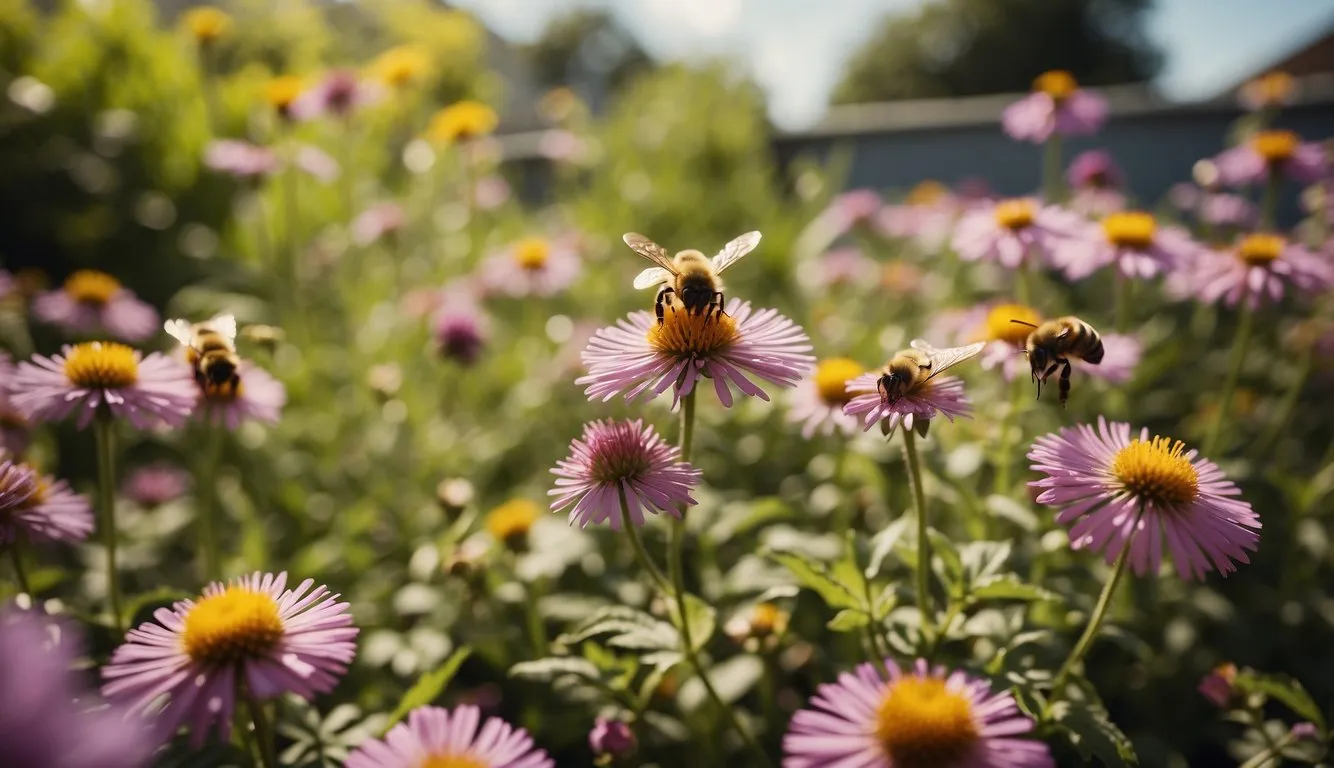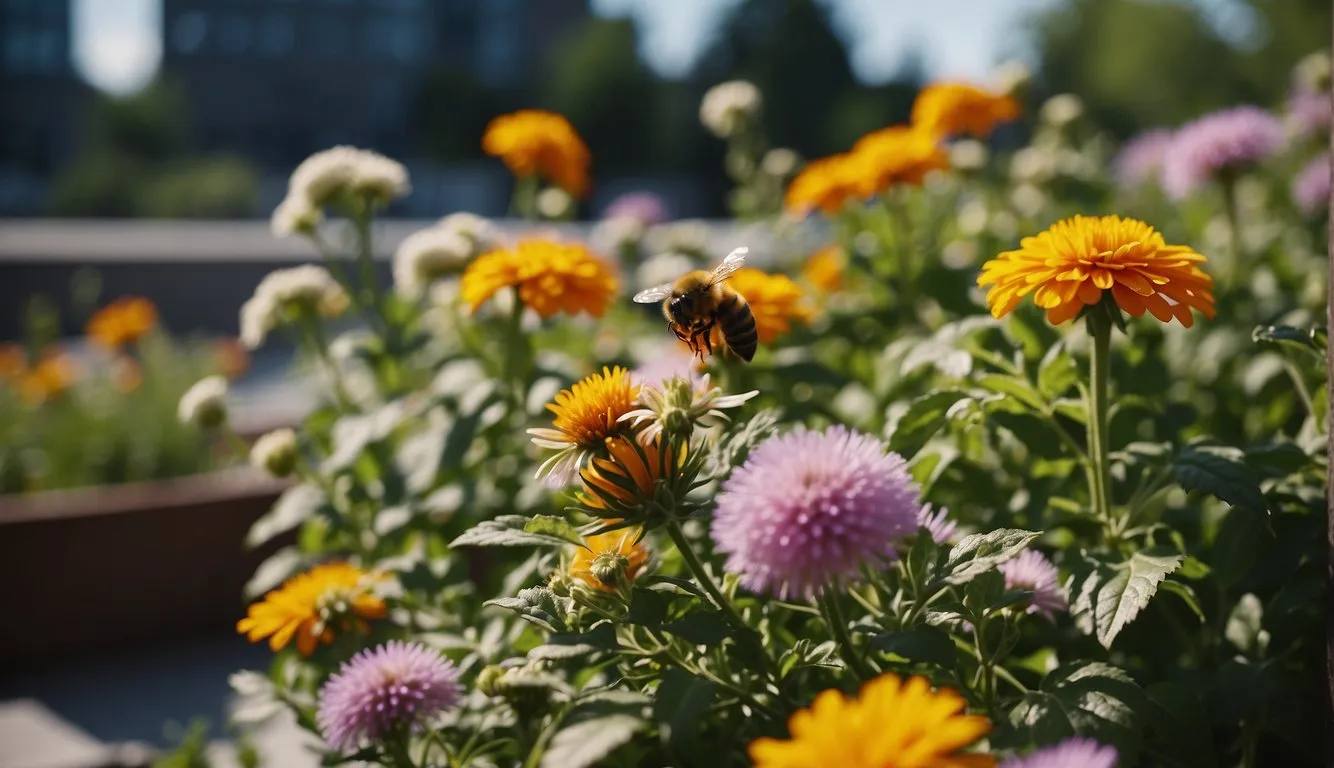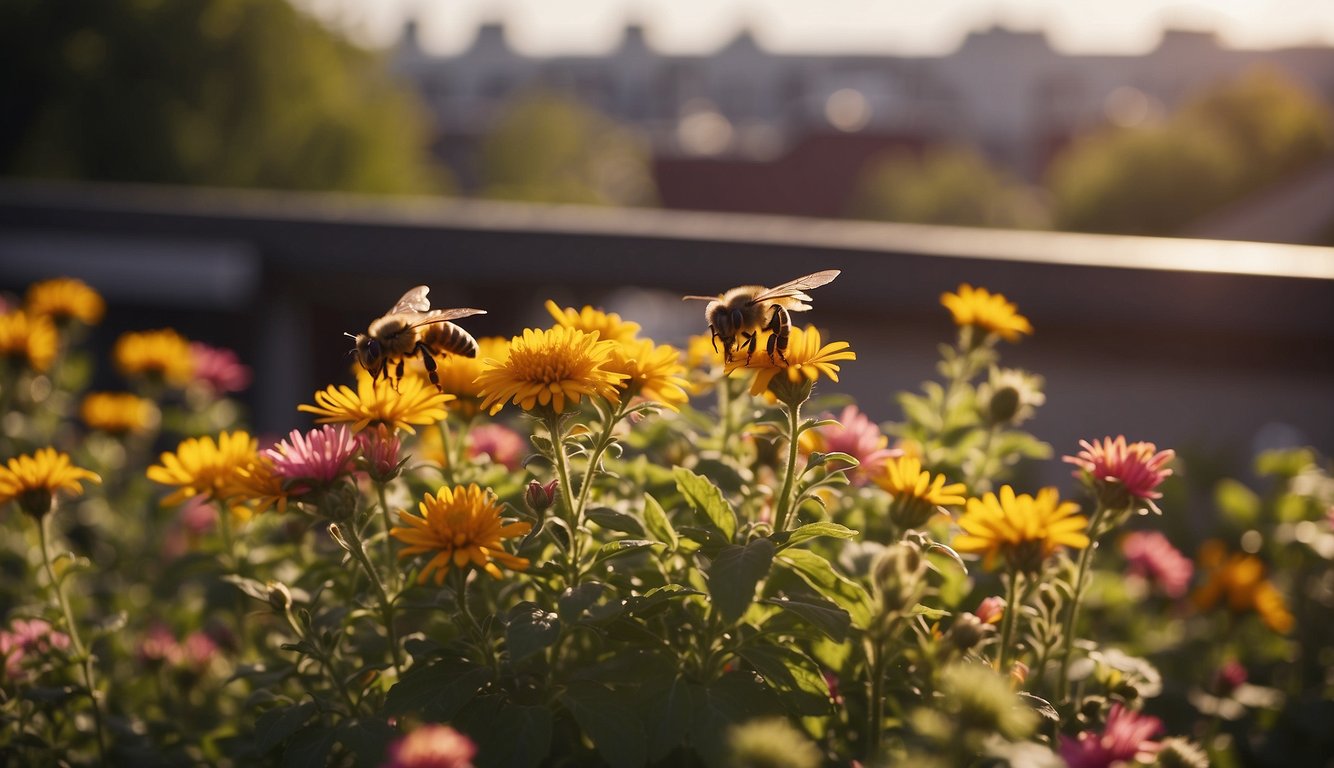Pollinator-friendly rooftop gardens are becoming increasingly popular in urban areas. These green spaces on rooftops are designed to attract and support pollinators like bees and butterflies. They provide a habitat and food source for pollinators, helping to maintain biodiversity and support ecosystem health in urban environments.

Understanding Pollinators is key to designing pollinator-friendly spaces. Pollinators are essential for the reproduction of many plant species, and they play a crucial role in maintaining urban biodiversity. However, many pollinator populations are threatened by habitat loss, pesticide use, climate change, and other factors. By creating pollinator-friendly spaces like rooftop gardens, we can help support these important species and promote conservation and biodiversity in our cities.
Seasonal considerations are also important when designing pollinator-friendly rooftop gardens. Different plants bloom at different times of the year, and it’s important to choose a variety of plants that will provide food and habitat for pollinators throughout the growing season. Additionally, urban pollinator gardens may face unique challenges like heat stress and water scarcity, so it’s important to choose plants that are well-suited to these conditions.
Table of Contents
Key Takeaways
- Pollinator-friendly rooftop gardens are becoming increasingly popular in urban areas, providing a habitat and food source for pollinators and helping to maintain biodiversity and support ecosystem health.
- Understanding pollinators is key to designing pollinator-friendly spaces, and seasonal considerations are important when choosing plants for urban pollinator gardens.
- By creating pollinator-friendly spaces, we can help support important species and promote conservation and biodiversity in our cities.
Understanding Pollinators
Pollinators are essential for maintaining the health of our ecosystem. They are responsible for the pollination of over 75% of our food crops and are critical to the reproduction of many plants. Pollinators include bees, butterflies, birds, and other insects that collect pollen and nectar from flowers.
Bees are the most important pollinators, and there are over 20,000 species worldwide. They are attracted to flowers by their bright colors and sweet nectar. Bees collect pollen on their bodies and transfer it to other flowers, allowing for cross-pollination. Native bees are especially important for pollination, as they are adapted to the local environment and are more effective pollinators than non-native bees.
Butterflies are also important pollinators, especially for plants with large flowers. They are attracted to bright colors and sweet nectar, and they collect pollen on their bodies as they move from flower to flower. Monarch butterflies are a particularly important species, as they are known for their long-distance migrations and are an indicator of the health of our ecosystem.
Birds are another important pollinator, and they are attracted to flowers with bright colors and sweet nectar. Hummingbirds are particularly effective pollinators, as they have long beaks that allow them to reach deep into flowers.
Pollination occurs when pollen from the male part of a flower is transferred to the female part of another flower. This allows for fertilization and the production of seeds. Pollinators are essential for this process, as they transfer pollen from flower to flower.
In order to attract pollinators, it is important to plant a variety of flowers that provide both pollen and nectar. Native plants are especially important, as they are adapted to the local environment and are more attractive to native pollinators. Providing habitat, such as nesting sites and water sources, is also important for supporting pollinators.
Overall, understanding the role of pollinators in our ecosystem is essential for maintaining a healthy and sustainable environment. By providing habitat and planting pollinator-friendly gardens, we can support these important species and ensure the health of our ecosystem for generations to come.
Designing Pollinator-Friendly Spaces
Creating a pollinator-friendly rooftop garden requires careful planning and design. In this section, we will discuss two key aspects of designing such a space: choosing the right plants and garden layout and structure.
Choosing the Right Plants
When selecting plants for a pollinator-friendly rooftop garden, it is important to choose a plant palette that provides a diverse range of flowers and foliage throughout the growing season. Native plants are an excellent choice as they are adapted to local growing conditions and provide essential habitat and food sources for local wildlife.
It is also important to consider the amount of sunlight your rooftop garden receives. Some plants require full sun, while others thrive in partial shade. Be sure to choose plants that are appropriate for your specific growing conditions.
Garden Layout and Structure
The layout and structure of your garden can also play a crucial role in creating a pollinator-friendly space. Consider incorporating a variety of different plant heights and structures to provide shelter and habitat for a range of wildlife.
In addition, be sure to include features such as water sources and nesting materials to further enhance the habitat value of your garden. Creating a diverse and structured garden will help attract a wide range of pollinators and other wildlife to your rooftop space.
In conclusion, designing a pollinator-friendly rooftop garden requires careful consideration of both plant selection and garden layout and structure. By choosing a diverse plant palette and incorporating a range of different plant heights and structures, you can create a thriving habitat for local wildlife and help support pollinator populations in your area.
Seasonal Considerations

When planning a pollinator-friendly rooftop garden, it is essential to consider seasonal changes. Different plants bloom at different times of the year, and pollinators have varying needs throughout the seasons. Here are some seasonal considerations to keep in mind:
Spring and Summer Blooms
Spring and summer are the peak seasons for pollinators. During this time, bees, butterflies, and other pollinators are actively searching for food sources. To attract pollinators to your rooftop garden during these seasons, consider planting a variety of perennials and flowering plants that bloom during this time. Some popular options include:
- Coneflowers (Echinacea)
- Black-eyed Susans (Rudbeckia)
- Bee Balm (Monarda)
- Milkweed (Asclepias)
- Liatris (Blazing Star)
It is also important to ensure that your garden has a consistent source of water during these seasons. A shallow dish filled with water or a small pond can provide pollinators with a place to drink and cool off.
Fall and Winter Maintenance
As the weather begins to cool down in the fall, pollinators start to prepare for winter. During this time, it is important to provide them with a source of food and shelter. Consider planting late-blooming perennials such as asters and goldenrods to provide pollinators with a food source during the fall.
In the winter, it is essential to ensure that your garden is well-maintained. Deadheading spent blooms and removing dead plant material can help prevent the spread of disease and pests. It is also important to provide pollinators with a place to hibernate during the winter. Consider leaving some dead plant material in your garden to provide shelter for bees and other pollinators.
By considering seasonal changes and providing pollinators with the resources they need, we can create a thriving pollinator-friendly rooftop garden that benefits both the environment and our communities.
Urban Pollinator Gardens

Pollinator-friendly rooftop gardens are an excellent way to provide food and shelter for bees, butterflies, birds, and other pollinators in urban areas. In this section, we will explore two types of urban pollinator gardens: rooftop and vertical gardens, and community and sidewalk gardens.
Rooftop and Vertical Gardens
Rooftop and vertical gardens are becoming increasingly popular in urban areas. They are a great way to add green space to an otherwise concrete jungle and provide a habitat for pollinators. Rooftop gardens are typically created using containers, while vertical gardens can be created using a variety of materials, including walls and trellises.
When creating a rooftop or vertical garden, it is important to choose plants that are well-suited to the growing conditions. These gardens are often exposed to more sun and wind than traditional gardens, so it is important to choose plants that can handle these conditions. Some great options for rooftop and vertical gardens include herbs, succulents, and native wildflowers.
Community and Sidewalk Gardens
Community and sidewalk gardens are another great way to create pollinator-friendly green spaces in urban areas. These gardens are typically located in public spaces, such as parks, schools, and community centers, and are maintained by volunteers.
When creating a community or sidewalk garden, it is important to choose plants that are well-suited to the growing conditions. These gardens are often located in areas with limited space and sunlight, so it is important to choose plants that can handle these conditions. Some great options for community and sidewalk gardens include milkweed, coneflowers, and black-eyed susans.
Overall, pollinator-friendly rooftop and community gardens are a great way to provide food and shelter for pollinators in urban areas. By choosing the right plants and creating the right growing conditions, we can create beautiful, sustainable green spaces that benefit both pollinators and humans alike.
Conservation and Biodiversity

As we continue to see the effects of urbanization and fragmentation on our environment, it is crucial that we take steps to protect and promote biodiversity. Pollinator-friendly rooftop gardens are one way we can do this. By providing a habitat and food source for pollinators like bees and butterflies, we can help maintain biodiversity and support ecosystem health in urban areas.
One of the main benefits of pollinator-friendly rooftop gardens is their ability to provide pollinator habitat. As the bee population continues to decline, it is more important than ever to provide safe spaces for these important pollinators to thrive. By planting wildflowers and other pollinator-friendly plants, we can create a habitat that supports the bee population and other pollinators.
In addition to supporting pollinator habitat, pollinator-friendly rooftop gardens also promote conservation efforts. By planting a variety of native plants, we can help protect and preserve local ecosystems. Native plants are adapted to the local environment and require less maintenance, making them a more sustainable option for rooftop gardens.
Overall, pollinator-friendly rooftop gardens are a powerful tool for promoting conservation and biodiversity in urban areas. By providing a habitat and food source for pollinators, we can help maintain healthy ecosystems and protect the declining bee population.
Conclusion

In conclusion, creating a pollinator-friendly rooftop garden is an excellent way to support ecosystem health in urban areas. By providing a habitat and food source for pollinators like bees and butterflies, we can help to maintain biodiversity and support the local ecosystem.
To create a successful pollinator-friendly rooftop garden, it is important to choose the right plants. Native plants are particularly effective because they are adapted to the local climate and soil conditions, making them more resilient and easier to maintain. It is also important to choose a variety of plants that bloom at different times of the year to provide a continuous food source for pollinators.
In addition to plants, we can also provide nesting sites and shelter for pollinators. This can be done by incorporating features like bee boxes, insect hotels, and birdhouses into the design of the rooftop garden.
Finally, it is important to maintain the garden regularly to ensure that it continues to provide a healthy habitat for pollinators. This includes removing weeds, pruning plants, and monitoring for pests and diseases. By following these guidelines, we can create a beautiful and thriving pollinator-friendly rooftop garden that supports the health of our local ecosystem.
Frequently Asked Questions

What are the essential features of a pollinator-friendly rooftop garden?
A pollinator-friendly rooftop garden is a vibrant green space on rooftops designed to attract and support pollinators like bees and butterflies. The essential features of a pollinator-friendly rooftop garden include native plants, which provide food and habitat for pollinators, as well as a water source, nesting sites, and reduced pesticide use. In addition, the garden should be designed to maximize sunlight exposure and drainage.
How can I attract a diverse range of pollinators to my rooftop garden?
To attract a diverse range of pollinators to your rooftop garden, you should plant a variety of native flowering plants that bloom at different times throughout the growing season. This will provide a continuous source of food for pollinators. You can also provide nesting sites for bees and other pollinators by installing bee houses or leaving dead wood and hollow stems in the garden. A water source, such as a bird bath or shallow dish filled with water, can also attract pollinators.
What maintenance practices should be followed to sustain a pollinator-friendly rooftop garden?
To sustain a pollinator-friendly rooftop garden, you should follow good maintenance practices, such as regular watering, fertilizing, and pruning. You should also monitor the garden for pests and diseases and use integrated pest management techniques to control them. In addition, you should remove dead or diseased plants and debris from the garden to prevent the spread of pests and diseases.
Can you recommend native plants that support rooftop garden pollinators?
Yes, we can recommend several native plants that support rooftop garden pollinators, including butterfly weed, bee balm, black-eyed Susan, coneflower, and goldenrod. These plants are attractive to a variety of pollinators and bloom at different times throughout the growing season, providing a continuous source of food for pollinators.
What design principles should be considered when creating a pollinator garden on a rooftop?
When creating a pollinator garden on a rooftop, you should consider several design principles, including maximizing sunlight exposure, selecting plants that are appropriate for the growing conditions, providing a water source, and ensuring proper drainage. You should also consider the size and layout of the garden, as well as the types of pollinators you want to attract.
What are the environmental benefits of establishing a pollinator-friendly rooftop garden?
Establishing a pollinator-friendly rooftop garden provides several environmental benefits, including increasing biodiversity in urban areas, improving air quality, reducing the urban heat island effect, and reducing stormwater runoff. In addition, pollinator-friendly rooftop gardens can provide a sustainable solution for cities by reducing the need for energy-intensive air conditioning and providing habitat for pollinators that are essential for food production.


